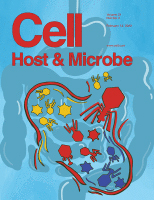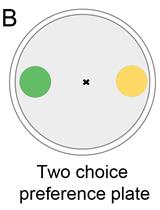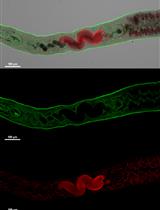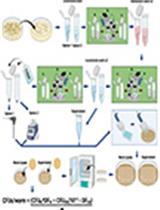- EN - English
- CN - 中文
Preparation of Nippostrongylus brasiliensis Larvae for the Study of Host Skin Response
用于研究寄主皮肤反应的巴西日圆线虫幼虫的制备
发布: 2020年12月20日第10卷第24期 DOI: 10.21769/BioProtoc.3849 浏览次数: 2776
评审: Kristin L. ShinglerKara FilbeyAyush Ranawade
Abstract
Hookworms are skin penetrating parasites, however in the laboratory the hookworm model Nippostrongylus brasiliensis, the parasite is traditionally administered subcutaneously bypassing the skin (epidermis and dermis). Here, we describe two complementary approaches for infecting mice with N. brasiliensis in order to study the skin immune responses. The first approach employs a skin percutaneous injection that is poorly efficient with the laboratory strain of the parasite in mice, but represents a natural infection. The second approach employs an intradermal injection of the parasite, allowing the controlled delivery of the parasitic larvae and leads to an infection that closely mimics the natural kinetics of parasite migration and development. Both of those infection models allow the investigator to study the skin immune response mounted against the parasite, in addition to detailed investigations of the early immunomodulatory strategies employed by the parasite during skin invasion.
Keywords: Nippostrongylus brasiliensis (巴西日圆线虫)Background
Hookworm larvae migrate from the skin to the lungs, before finally reaching the intestine, where they complete their maturation into adult worms and start to reproduce. Immunity against hookworms arise during each of these developmental phases and following both primary and secondary infections (Bouchery et al., 2017). Whilst the host immune responses against the lung and intestinal phases of the parasite infection are well characterised, the skin response has only been partially characterised as current models that utilize the rodent hookworm, Nippostrongylus brasiliensis (Nb), traditionally deliver the infectious larvae via the subcutaneous route of infection bypasses the skin de-facto. To counteract this problem, we developed two methods of infection that allow investigation of the skin-penetrating phase. These models utilize an intradermal infection of infective larvae, allowing the delivery of a controlled dose of the parasite, or the topical application of larvae mimicking the natural skin penetration of hookworms (Gharib, 1955).
Hookworms undergo their transition from a free-living organism to an infective parasite as they migrate through the skin and as such this is the first site where the parasite needs to express products aimed at the modulation of the host immune response. Indeed, we have recently used the protocols described herein to demonstrate the production of a DNAse II by skin penetrating hookworm larvae which acts to degrade neutrophil extracellular traps and thus evade killing by host neutrophils (Bouchery et al., 2020). It is likely that many additional interactions occur between the host and the parasite within the skin but that these remain to be characterised. Further study of such interactions could provide an important avenue for the identification of new vaccine targets against hookworms. Furthermore, the study of immunomodulatory events that occur early after infection could provide potential new treatments against inflammatory diseases.
The skin penetration route is already widely employed in experimental studies of Schistosomiasis infection (Winkel et al., 2018; Haas and Haeberlein, 2009), and we expect our methodology could easily be adapted to other skin penetrating helminths, such as Strongyloides spp (Jannasch et al., 2015).
Materials and Reagents
10 μl XL Freload Reload System pipette tips, low retention, sterile (Interpath Services, catalog number: 33410 )
1.5 ml microcentrifuge tube, graduated, boil proof, sterile (DNAase & RNAase free) (SSI, sold by Interpath Services, catalog number: MCT-175-C )
Insulin syringe 29 G, 12.7 cm, 0.5 ml ultrafine (BD, catalog number: BDM00183 )
15 ml Conical Centrifuge Tubes (BD FalconTM, catalog number: BD352096 )
Tape (generic medical tape, for example Transpore surgical tape, or Nexcare medical tape strong hold, 3M Health care, Australia)
Tissue Kimwipes (Kimberly-Clark, catalog number: 18821277 )
SuperFrost Slides (Menzel, sold by Thermofisher, catalog number: MENSF21201/40NC )
3.5 ml flexible plastic pasteur pipette (Samco, sold by Thermofisher, catalog number: BER225-1S[EA]
N. brasiliensis L3 infective larvae (iL3) (Camberis et al., 2003)
Note: Camberis et al. (2003) provides a detailed review on the preparation of N. brasiliensis. Store at 26 °C.
PBS (DPBS, no calcium, no magnesium) (GibcoTM, sold by ThermoFisher Scientific, catalog number: 14190144 )
Penicillin/Streptomycin 10,000 U/ml (GibcoTM, sold by ThermoFisher Scientific, catalog number: 15140122 , store at 4 °C)
Gentamicin solution 10 mg/ml (Sigma-Aldrich, catalog number: G1272 , store at 4 °C)
Virkon 5-gram tablet (DuPont, catalog number: 500607 )
Antibiotic wash solution (see Recipes)
Equipment
Stereomicroscope (Nikon, SMZ1000)
Tweezers (Student Dumont #5 Forceps, Fine Science Tools, sold by DANIELS HEALTH LABORATORY PRODUCTS, catalog number: 91150-20)
Procedure
文章信息
版权信息
© 2020 The Authors; exclusive licensee Bio-protocol LLC.
如何引用
bouchery, T., Coakley, G. and Harris, N. L. (2020). Preparation of Nippostrongylus brasiliensis Larvae for the Study of Host Skin Response. Bio-protocol 10(24): e3849. DOI: 10.21769/BioProtoc.3849.
分类
微生物学 > 微生物-宿主相互作用 > 线虫
免疫学 > 动物模型 > 小鼠
您对这篇实验方法有问题吗?
在此处发布您的问题,我们将邀请本文作者来回答。同时,我们会将您的问题发布到Bio-protocol Exchange,以便寻求社区成员的帮助。
提问指南
+ 问题描述
写下详细的问题描述,包括所有有助于他人回答您问题的信息(例如实验过程、条件和相关图像等)。
Share
Bluesky
X
Copy link













